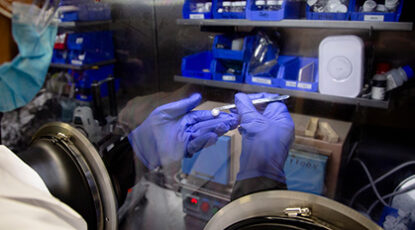Innovation
-
‘Holy grail’ battery doubles the range of electric vehicles
Lithium metal batteries can double the capacity of today’s standard lithium-ion cells, and much of the existing manufacturing system is primed for production, say experts at U-M. Let’s roll!
-
‘Young Sharks’ gives fourth graders an entrepreneurial edge
A creative UM-Flint program exposes elementary school-aged children to business, startups, and all the possibilities that can spring from their curiosity and creativity.
-
Is the end in sight?
Get an inside look at the COVID-19 vaccine development and approval process with U-M Professor of Epidemiology Arnold Monto. He is the acting chair of the FDA’s Vaccines and Related Biological Products and Advisory Committee.
-
Michigan Medicine vaccinates first employees for COVID-19
Michigan Medicine began vaccinating people against COVID-19 Dec. 14 with an initial group of five frontline workers.
-
Partnership with veterans impacts prehospital setting
Critical care researchers and veterans are bringing new medical devices used to stop hemorrhage bleeds on the battlefield to civilian life.
-
Michigan Medicine separates conjoined twins
Two dozen specialists, aided by 3D printed models, recently separated 1-year-old sisters attached at the chest and abdomen. The surgery took 11 hours.
-
Paul Milgrom, BA ’70, awarded Nobel Prize
The 2020 Nobel Prize in Economic Sciences recognizes Milgrom’s work in improving auction formats. He and fellow researcher Robert Wilson were awarded the prize for their research about auction theory.
-
U-M shifts to saliva-based surveillance testing for COVID-19
Changes include streamlined sign-up, more locations, 6K weekly capacity.
-
Satellite clerk’s office at UMMA registers thousands to vote
The satellite city clerk’s office registers about 150-200 students per day. As of Oct. 13, more than 2,600 students registered and more than 2,900 voted in person at UMMA or by returning their ballot to the museum’s drop box.










